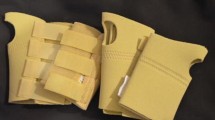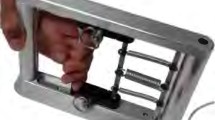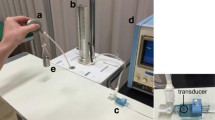Abstract
Purpose
To set a baseline measurement of the number of hand flexion–extension cycles and analyse the degree of motion in young healthy individuals, measured by leap motion controller (LMC), besides describing gender and dominant hand differences.
Methods
Fifty healthy participants were asked to fully grip-and-release their dominant hand as rapidly as possible for a maximum of 3 min or until subjects fatigued, while wearing a non-metal wrist splint. Participants also performed a 15-s grip-and-release test. An assessor blindly counted the frequency of grip-and-release cycles and magnitude of motion from the LMC data.
Results
The mean number of the 15-s G–R cycles recorded by LMC was: 47.7 ± 6.5 (test 1, LMC); and 50.2 ± 6.5 (test 2, LMC). In the 3-min test, the total number of hand flexion–extension cycles and the degree of motion decreased as the person fatigued. However, the decline in frequency preceded that of motion’s magnitude. The mean frequency of cycles per 10-s interval decreased from 35.4 to 26.6 over the 3 min. Participants reached fatigue from 59.38 s; 43 participants were able to complete the 3-min test.
Conclusions
Normative values of the frequency of cycles and extent of motion for young healthy individuals, aged 18–35 years, are provided. Future work is needed to establish values in a wider age range and in a clinical setting.









Similar content being viewed by others
References
Alagha MA, Alagha MA, Dunstan E, Sperwer O, Timmins KA, Boszczyk BM (2017) Development of a new assessment tool for cervical myelopathy using hand-tracking sensor: Part 1: validity and reliability. Eur Spine J. doi:10.1007/s00586-017-4948-3
Bohannon RW (2003) Grip strength: a summary of studies comparing dominant and nondominant limb measurements. Percept Mot Skills 96(1):728–730. doi:10.2466/pms.2003.96.3.728
Bohannon R, Peolsson A, Massy-Westropp N, Desrosiers J, Bear-Lehman J (2006) Reference values for adult grip strength measured with a Jamar dynamometer: a descriptive meta-analysis. Physiotherapy 92(1):11–15. doi:10.1016/j.physio.2005.05.003
Crosby CA, Wehbe MA (1994) Hand strength: normative values. J Hand Surg 19(4):665–670. doi:10.1016/0363-5023(94)90280-1
Günther C, Bürger A, Rickert M, Crispin A, Schulz C (2008) Grip strength in healthy caucasian adults: reference values. J Hand Surg 33(4):558–565. doi:10.1016/j.jhsa.2008.01.008
Hosono N, Sakaura H, Mukai Y, Kaito T, Makino T, Yoshikawa H (2008) A simple performance test for quantifying the severity of cervical myelopathy. J Bone Joint Surg 90-B(9):1210–1213. doi:10.1302/0301-620X.90B9.20459
Hosono N, Makino T, Sakaura H, Mukai Y, Fuji T, Yoshikawa H (2010) Myelopathy hand: new evidence of the classical sign. Spine 35(8):E273–E277. doi:10.1097/BRS.0b013e3181c6afeb
Machino M, Imagama S, Ando K, Kobayashi K, Hida T, Ito K, Tsushima M, Matsumoto A, Tanaka S, Morozumi M, Ito K, Kato F, Nishida Y, Ishiguro N (2016) Prospective comparison of age- and sex-related differences in quantifiable 10-s grip and release and 10-s step test results for diagnosis of cervical spondylotic myelopathy in 454 patients with cervical spondylotic myelopathy and 818 asymptomatic subjects. Spine (Phila Pa 1976). doi:10.1097/BRS.0000000000001849
Massy-Westropp N, Gill T, Taylor A, Bohannon R, Hill C (2011) Hand grip strength: age and gender stratified normative data in a population-based study. BMC Res Notes 4(1):127–129. doi:10.1186/1756-0500-4-127
Ono K, Ebara S, Fuji T, Yonenobu K, Fujiwara K, Yamashita K (1987) Myelopathy hand. New clinical signs of cervical cord damage. J Bone Joint Surg (Br) 69(2):215–219
Petersen P, Petrick M, Connor H, Conklin D (1989) Grip strength and hand dominance: challenging the 10% rule. Am J Occup Ther 43(7):444–447. doi:10.5014/ajot.43.7.444
Roberts H, Denison H, Martin H, Patel H, Syddall H, Cooper C, Sayer A (2011) A review of the measurement of grip strength in clinical and epidemiological studies: towards a standardised approach. Age Ageing 40(4):423–429. doi:10.1093/ageing/afr051
Wada E, Yonenobu K, Fukui M, Hirota Y, Kikuchi S, Toyama Y, Kawakami M, Atsushi S (2003) Grip and release test (10 seconds test) in healthy volunteers and cervical myelopathy patients—a simple bedside test for the assessment of cervical myelopathy. Cerv Spine Res Soc 112–113. http://www.csrs.org/grip-and-release-test-10-seconds-test-in-healthy-volunteers-and-cervical-myelopathy-patients-a-simple-bedside-test-for-the-assessment-of-cervical-myelopathy/. Accessed 21 Aug 2016
Wada E, Yonenobu K, Fukui M, Hirota Y, Kikuchi S, Toyama Y, Kawakami M, Seichi A (2004) Intraobserver reliability of grip and release test (10-second test) in healthy volunteers and cervical myelopathy patients. Cerv Spine Res Soc 261–263. http://www.csrs.org/intraobserver-reliability-of-grip-and-release-test-10-second-test-in-healthy-volunteers-and-cervical-myelopathy-patients/. Accessed 21 Aug 2016
Weichert F, Bachmann D, Rudak B, Fisseler D (2013) Analysis of the accuracy and robustness of the leap motion controller. Sensors 13(5):6380–6393. doi:10.3390/s130506380
Yukawa Y, Nakashima H, Ito K, Machino M, Kanbara S, Kato F (2013) Quantifiable tests for cervical myelopathy; 10-s grip and release test and 10-s step test: standard values and aging variation from 1230 healthy volunteers. J Orthop Sci 18(4):509–513. doi:10.1007/s00776-013-0381-6
Author information
Authors and Affiliations
Corresponding author
Ethics declarations
Conflict of interest
The authors declared no conflict of interest.
Ethical approval
Obtained by The University of Nottingham.
Ethics reference no.
F12032015 SoM Spinal Surg.
Funding
The study was funded by Nottingham University Hospitals (Spine Research). Bbraun and VRmed supported the design of the software. The companies had no role in the design, interpretation or reporting of the study.
Electronic supplementary material
Below is the link to the electronic supplementary material.
Rights and permissions
About this article
Cite this article
Alagha, M.A., Alagha, M.A., Dunstan, E. et al. Development of a new assessment tool for cervical myelopathy using hand-tracking sensor: Part 2: normative values. Eur Spine J 26, 1298–1304 (2017). https://doi.org/10.1007/s00586-017-4949-2
Received:
Revised:
Accepted:
Published:
Issue Date:
DOI: https://doi.org/10.1007/s00586-017-4949-2




